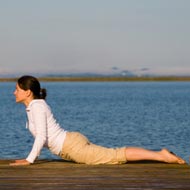- Aromatherapy (36)
- Benefits of Yoga (282)
- Home Remedies (1087)
- massage therapy (9)
- Preventive Therapy (135)
- Running (41)
- Skin Care (15)
- Stress Relief (25)
- Stretching (5)
- walking (33)
- Womens Health (14)
- Yoga Benefits for Pregnant Women (16)
- Yoga Benefits for Students (3)
- Yoga for Children (11)
- Yoga for Holistic Living (37)
- Yoga for Midlife Crisis (3)
- Yoga for Senior Citizens (2)
- Yoga for the Workplace (1)
- Yoga Health Tips (185)
- Yoga Practice during Menstruation (5)
Routine Yoga Specific Guidelines

What Is The Best Time To Do Yoga
While there is no specific ‘best time’ to do yoga, there are certain guidelines which if followed can lead to optimum results from performing these postures (asanas).
- Morning is usually considered the best time, since the mind is fresh and energy levels are their highest. After waking, evacuate your bowels, take a bath if you wish to and then start your yoga practice.
- Early evening is also a good time to do yoga, because the body becomes more flexible by that time. Even if you are feeling tired, doing yoga will relieve your fatigue and infuse you with energy and vigor. That is because yoga postures increase the intake of oxygen.
- While you need not be rigid about the best time of the day when you practice your yoga regimen, do not practice it immediately after eating a meal. Wait for 2-3 hours after a meal or one hour after eating a light snack. Yoga must essentially be done on an empty stomach. Wait at least half an hour after exercising before eating.
- Since the exercises have a stimulating effect, do not practice them just before going to bed.
- Do not take a hot bath immediately after completing your yoga postures, since this will draw the blood away from the muscles and organs to the skin. Wait for fifteen minutes or more before doing so.
- Select a quiet, clean and cool place with lots of fresh air for your exercises, so that there is no disturbance to your meditation.
- While it is alright to do it outdoors, avoid direct sunlight.
- Do not do yoga immediately after coming in from the sun or after sun-bathing.
- Do not practice your exercises if you are under the influence of alcohol or any other drug which may alter your judgment.
- It is advisable to consult a doctor and a trained yoga teacher before starting on a yoga regimen, if you are suffering from certain disabilities or chronic ailments. One should avoid yoga postures like head stands in certain conditions like dizziness, high blood pressure or some eye problems.
- Follow the correct pattern of asanas, followed by pranayama and then meditation, for the best results.
- If you are new to yoga, start gently and don’t overdo it. You may feel a slight soreness or ache in your neck, back or shoulder muscles for the first week or two. Don’t give up; just continue at a steady pace.
If you follow these guidelines, you are sure to get more benefit out of your yoga routine.
« Previous blog Is Yoga Helpful For Person Suffering From Sciatica?
Next blog » Effective Yoga Posture Put Limited Pressure On Wrist
ADVERTISEMENT
Related Questions
- RSS Feeds -
- All posts
- All comments
Related Articles
- Guidelines for Kids Yoga Yoga is great for adults... but we already know that! Did you know that you c...
- Yoga as a cure for hangovers If you have been partying out a bit too much and are paying the price the mor...
- Yoga for Whiplash Whiplash is a surprisingly common injury that usually occurs as a result of a...
- Walking Calorie Calculator Most people, who walk for fitness, do so to burn calories, lose weight and st...
Related Topics
Categories